-
Car Reviews
- All reviews
- Midsize SUVs
- Small cars
- Utes
- Small SUVs
- Large SUVs
- Large cars
- Sports SUVs
- Sports cars
- Vans
Latest reviews
- Car News
-
Car Comparisons
Latest comparisons
- Chasing Deals
For a brand that once specialised in sports cars alone, Jaguar proved with the midsize F-Pace that they are remarkably adept at building SUVs, too. Undoubtedly, it’s useful that Jaguar’s partner is four-wheel-drive specialist Land Rover, but the F-Pace was its own car, with a distinctive Jaguar character. But it’s actually smaller SUVs that are selling in the biggest numbers. To meet this demand, the British marque has revealed the 2018 Jaguar E-Pace, an SUV close in size to a Mercedes GLA or Audi Q3, but intelligently packaged to offer cargo space closer to that of the larger BMW X3 or Mercedes-Benz GLC.
Starting at $48,000 in Australia, the E-Pace range will span five engines – two petrols, and three diesels – and various trim levels, capped off with a First Edition expected to be priced around $85,000.
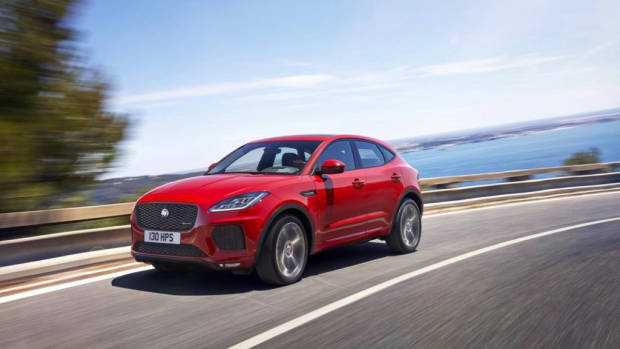
With muscular haunches and sporty lines reminiscent of Jaguar’s F-Type halo model, the E-Pace manages to pull off the wide and stubby aesthetic with aplomb. At nearly two metres wide, it’s stocky – but that’s led to a wide rear cabin, and a particularly large boot, making the Jaguar the most practical of the small luxury SUV set. As the F-Pace does in the class above, the E-Pace really sits between German SUV sizes, providing a ‘not too big, not too small’ option in the segment.
But the E-Pace has much more in common with the Range Rover Evoque than it does with its F-Pace brother. Like the Evoque and the Land Rover Discovery Sport, the E-Pace sits on Jaguar Land Rover’s steel-based LR-MS platform, rather than the F-Pace’s all-aluminium, rear-driven iQ[Al] chassis.
As a result, the E-Pace is actually a predominantly front-wheel-drive car, which runs against Jaguar’s focus on rear-drive dynamics. To counter this, every E-Pace that reaches Australia will have all-wheel-drive tuned to replicate Jaguar’s ‘unmistakable…rear-wheel-drive character’.
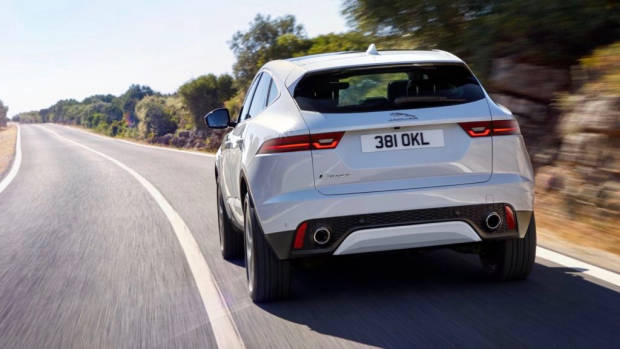
In recent years, Jaguar and Land Rover’s refreshed range of interesting and highly relevant cars has led to substantially increased customer demand. As a result, the company’s English factories are nearly at capacity – a problem exacerbated by the arrival of the new Range Rover Velar this year. As a result, the E-Pace actually won’t be built in England – it will be built by contractor Magna Steyr in Austria. Whether production shifts back to the United Kingdom once supply meets demand remains to be seen.
Globally, the E-Pace will be offered with five engines. All of them are turbocharged, Ingenium four-cylinders, and all have been built in-house by Jaguar, representing the first Jaguar model that has been a clean break from the previous Ford ownership era. Two petrols, and three diesels, will be on offer. The engines are branded under a new naming strategy.
The entry-level car is a diesel called D150, featuring a 110kW and 380Nm tune of the two-litre. It’s the cleanest, producing 147g/km of CO2, and it will be the only engine offered with the choice of a six-speed manual gearbox.
From there, it’s a step to the D180, which uses the more familiar 132kW, 430Nm tune of the Ingenium diesel. It’s here that a nine-speed automatic built by ZF Sachs becomes standard.
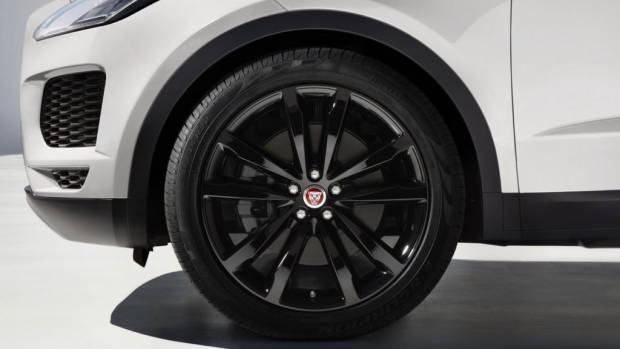
The flagship diesel engine – and our early pick at the sweetest choice in the range – is the D240, a high-powered, twin-turbo tune of the diesel producing 177kW, and a stout 500Nm of torque. This engine is capable of towing up to 1,800kg braked.
On the petrol front, the P250 is a 183kW, 365Nm two-litre turbo, while the P300 will be the fastest E-Pace, making 220kW and 400Nm from its tune of the same engine and sprinting to 100km/h from a standstill in 6.4 seconds.
While the E-Pace sits on the Evoque’s older platform, it does benefit from some of the underpinnings of the F-Pace and XE – primarily through the use of the innovative Integral Link rear suspension from those models. In our experience, this not only rides well, but is also compactly packaged, creating taller boot space.
The E-Pace sees the debut of Jaguar’s new ‘Active Driveline’ all-wheel-drive system. In normal conditions the rear axle is entirely disconnected for boosted economy, but the E-Pace is also capable of distributing nearly 100% of torque to the rear axle in dynamic driving conditions, within 100 milliseconds. It’s a technology that should breathe some new life into this relatively aged front-drive platform.
Adaptive dampers will be optional, and are triggered by drive modes in the E-Pace’s Configurable Dynamics system, which changes the damping, throttle response, gearbox shift points and steering weight profiles for more comfortable or sportier driving.
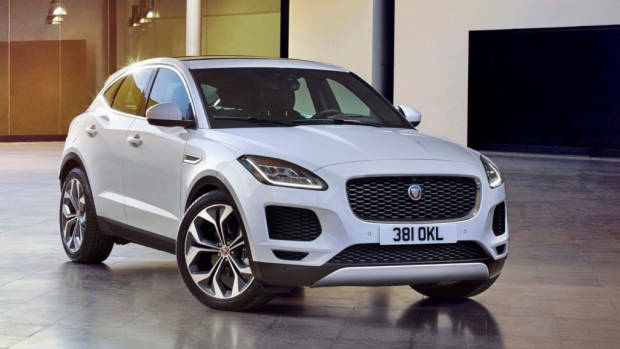
Various adaptive safety technologies will be available, although precise Australian specifications are yet to be determined. A reversing camera, plus front and rear parking sensors, will be standard. Otherwise, technologies available on the E-Pace include autonomous emergency braking with pedestrian detection, radar cruise control, lane keep assist, driver fatigue detection, blind spot assist, rear and forward cross traffic alert, and a pedestrian airbag.
Plus, Jaguar has borrowed Land Rover’s all-terrain progress control, which functions like cruise control off-road between 1.8km/h and 30km/h.
It’s not an easy task to stretch, raise and then miniaturise the look of a car, but the E-Pace manages to look like a smaller F-Pace while remaining reminiscent of the F-Type sports car.
The larger headlights are inspired by the F-Type, while the muscular grille, emphasised haunches and swept-back roofline are cues from Jaguar’s more recent XE and XF sedans. The short overhangs see the wheels pushed right to the corners to open up more passenger and cargo space.
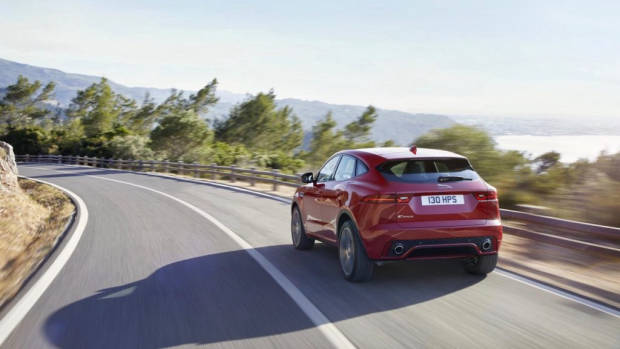
There seems to be some confusion in early reporting about what cars the E-Pace competes with. Like the F-Pace, the E-Pace is effectively sized between classes.
At 4,395mm wide, the E-Pace is shorter than the 4.4 metre Mercedes-Benz GLA and BMW X1, and the Jaguar is just a millimetre longer than an Audi Q3. But the E-Pace is much wider – at 1,984mm, it is nearly two metres mirror to mirror. By contrast, a GLA is more like 1.8 metres wide.
That width – and the fact the E-Pace is as tall as a Mercedes GLC – is what has produced a larger boot than those German rivals.
Design-wise, the E-Pace’s interior combines cues from throughout the Jaguar Land Rover stable. The E-Pace reintroduces one of the best features of the F-Type’s cabin – the leather-lined passenger grab handle that frames the centre stack. The stack, like the flat glovebox fascia, is more like that in the Land Rover Discovery Sport.
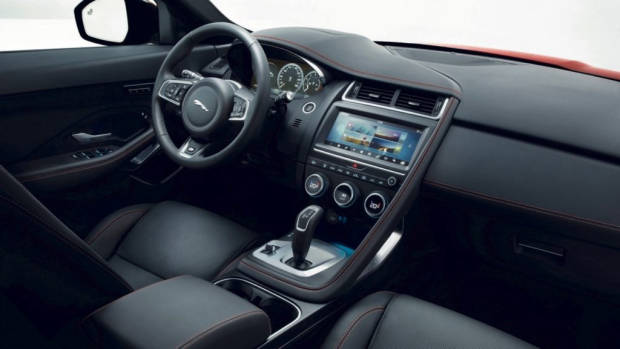
Impressively, Jaguar have ditched their smaller 8-inch touchscreen in the E-Pace; the faster, crisper 10-inch InControl Touch Pro screen is standard fit. It now has integration with apps like Spotify, but there’s still no word on when Apple CarPlay and Android Auto to Jaguar and Land Rover product, despite Australian representatives of the brand recently confirming that level of integration is on the horizon.
The E-Pace sees the debut of Jaguar’s next-generation heads-up display, which replaces the old Ford-era HUD with a much larger, full-colour version capable of projecting speed and navigation data at all times, with additional graphics for the infotainment and convenience functions when required.
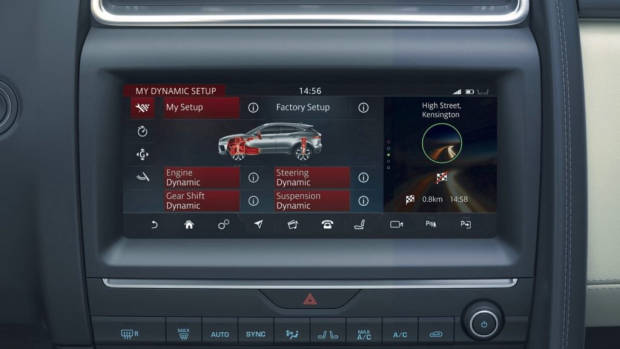
Ahead of the driver, a 12.3-inch full-colour digital driver display will be optional, as will be a choice of two premium Meridian stereos.
Up to five USB ports, and four 12 volt sockets, will be available and a 4G Wi-Fi hotspot capable of hosting eight devices will also be optional.
A downloadable smartphone and smart watch app will allow owners to interact with the E-Pace on the fly. The car can be tracked by linking in with the Jaguar’s GPS chip, while real-time updates of the fuel level and odometer reading will be visible. Plus, the E-Pace can be pre-cooled, pre-heated and remotely started from the app.
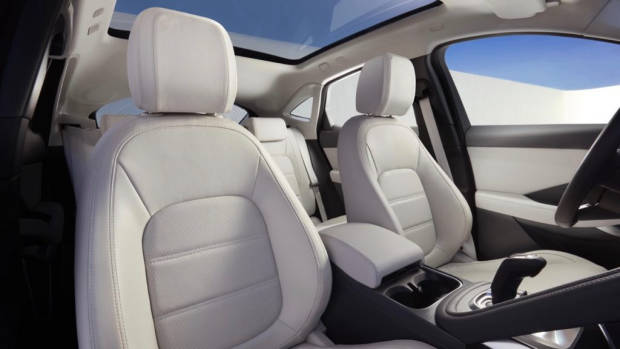
In a pleasant surprise, the E-Pace returns to the use of a relatively conventional automatic gear selector. It’s the self-centering unit found in the Range Rover Sport, and Jaguar F-Type. We prefer this to the rotary dial seen on more recent Jaguar and Land Rover products.
We haven’t seen the rear seat room yet, but the E-Pace has a large boot for the class, measuring 577 litres. That’s sufficient to fit a pram, a set of golf clubs, and a large suitcase at the same time. It expands to 1,234 litres when folded. An optional gesture tailgate can be opened and closed with a wave of the foot.
The E-Pace will arrive in Australia before the middle of 2018, likely with a release during autumn 2018. Full pricing and specification will be announced for Australia before then, which you’ll be able to read on Chasing Cars.
Latest news
About Chasing cars
Chasing Cars reviews are 100% independent.
Because we are powered by Budget Direct Insurance, we don’t receive advertising or sales revenue from car manufacturers.
We’re truly independent – giving you Australia’s best car reviews.